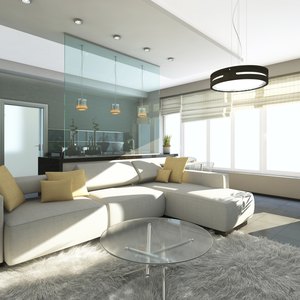
Renting a furnished house or apartment is appealing to many people, especially those who only plan to stay somewhere short term or do not have a lot of money to buy furnishings. If you are a property owner, renting furnished properties helps you fill a niche in the market and could be a lucrative option, if you charge the right amount of rent each month.
Tips
You can charge more rent for a fully furnished apartment. The extra funds can be used to replace the furniture in the future if it becomes worn or broken.
Why Charge More
If you rent a home or apartment that is furnished, whether it is completely furnished with furniture, linens, electronics and accessories or includes just some basic furniture, you can charge tenants higher rent. You had to purchase the items that are furnishing the house, and will need to replace those items if they are damaged or destroyed.
A higher monthly rent will recoup those costs. It is up to you as the landlord to determine how much more you want to charge for the furnishings, but typically landlords will base the increased cost on the condition and style of the furnishings. For example, a property that includes a brand-new, modern living room set is worth more than one that includes mismatched pieces with frayed seams.
Furnished Apartment Security Deposits
In addition to or instead of a higher rent for a furnished apartment, you could ask for a higher security deposit on the rental. Collecting more money up front can help you cover the costs of repairing or replacing the items in the furnished apartment if they are damaged.
Check with your state laws before collecting the security deposit, though. Some states have laws regulating security deposits and what landlords can charge. If you do not want to include it in the security deposit, you could also charge a separate cleaning fee for the rental, to pay for the costs of cleaning furniture, bedding, curtains and other items.
Itemize Your Furnishings
To protect your investment when renting a furnished apartment, it's wise to provide the tenant with an itemized list of the items included in the apartment rental. Be very specific; list the number of plates, bowls and cups, for example, and describe items as accurately as possible.
List the replacement cost of each item if it is damaged beyond normal wear and tear, or if the tenant takes the item with him when he moves out. Indicate if the replacement cost will be taken out of the security deposit, or if the tenant will need to pay you directly for the items. Have the tenant sign a copy of this inventory so there are no surprises when the rental comes to an end.
Setting the Monthly Rent
When you set the rent for your furnished apartment, be careful to not price yourself out of the market. If you set the rent too high, you may not be able to rent the apartment to anyone. If you are concerned about your furnishings, you may be better off to sell or store them and rent the apartment unfurnished.
In general, you should set the rent based on your expenses to own and maintain the property, including the furnishings, plus your desired rate of return on your investment. For example, if it costs you $15,000 per year to own and maintain the property, and you want to make $5,000 per year on the property, the annual rent should be $20,000, or about $1,675 per month. Compare that cost to other rents in the area, taking into account the features and furnishings of your property, and charge rent that will meet your needs yet still be competitive.
References
Writer Bio
An adjunct instructor at Central Maine Community College, Kristen Hamlin is also a freelance writer on topics including lifestyle, education, and business. She is the author of Graduate! Everything You Need to Succeed After College (Capital Books), and her work has appeared in Lewiston Auburn Magazine, Young Money, USA Today and a variety of online outlets. She has a B.A. in Communication from Stonehill College, and a Master of Liberal Studies in Creative Writing from the University of Denver.
